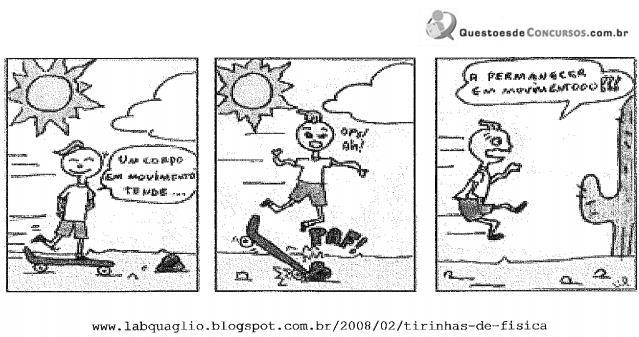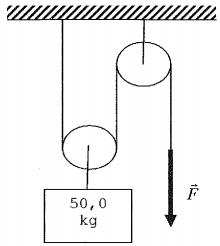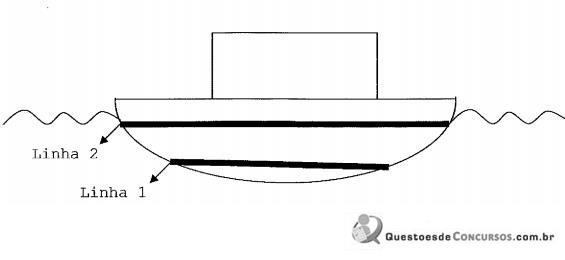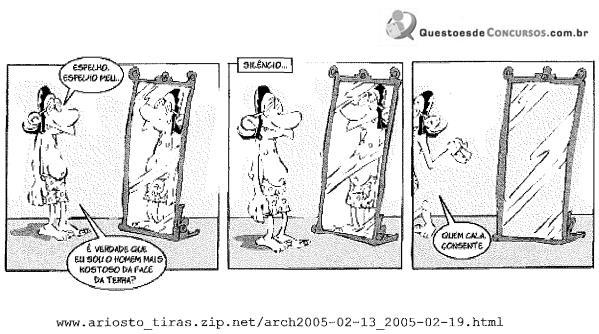Questões Militares
Para marinheiro
Foram encontradas 780 questões
Resolva questões gratuitamente!
Junte-se a mais de 4 milhões de concurseiros!
"Água que nasce na fonte serena do mundo... ´Águas que banham aldeias e matam a sede da população... Agua que o sol evapora pro céu vai embora virar nuvens de algodão... E sempre voltam humildes pro fundo da terra... Terra! Planeta Água".
Fonte: www.letras.mus.br/guilherme-arantes/46315/
Assinale a opção que indica as tres etapas do ciclo da água que estão representadas no trecho de musica acima.

Assinale a opção que indica a lei da Física que foi parcialmente representada na figura acima.

Alguns marinheiros são designados para abastecer um armazém (paiol) de explosivos com caixas de 50,0 kg de explosivos cada uma. Para levantar cada caixa com maior facilidade os marinheiros montaram uma associação de roldanas representadas na figura acima.
Qual a intensidade da força F , em newtons, que um marinheiro deve exercer para manter uma caixa em equilíbrio estático ou faze-la subir com velocidade constante?
Dado: Considere a aceleração local da gravidade g = 10 m/s2.

Assinale a opção que completa corretamente as lacunas da sentença abaixo.
Durante construção de um navio, são pintadas linhas horizontais a uma certa distancia de sua parte inferior (chamadas de calado) a fim de demarcar o limite do nível da água. Um navio possui duas dessas marcas como mostra a figura acima. Sabendo que esse navio e utilizado tanto nos rios quanto nos oceanos e que os oceanos são mais densos que as águas dos rios, e correto afirmar que a linha ______ representa o limite do nível da água ___ .
Corrente elétrica Dano biológico
De 0,01 A ate 0,02 A Dor e contração muscular
De 0,02 A ate 0,1 A Parada respiratória
De 0,1 A ate 3 A Fibrilação ventricular que pode ser fatal Acima de 3 A Parada cardíaca e queimaduras graves www.mundoeducacao.com/fisica/os-efeitos-corrente-e...
A tabela acima apresenta valores de corrente elétrica e as consequências para a saúde dos seres humanos. Para medir a corrente elétrica a que uma pessoa fica submetida deve-se dividir a diferença de potencial (ddp) em volts (V) pela resistência elétrica em Ohms (Q). Desta forma, assinale a opção que indica a consequência para uma pessoa que tenha uma resistência elétrica de 2000 Q e fica submetida a uma ddp de 100 V de uma rede elétrica.
( ) Oersted descobriu que uma corrente elétrica em um fio produz um campo magnético ao redor do fio que altera o sentido do ponteiro da bússola.
( ) Ampére descobriu que a atração ou repulsão entre dois fios percorridos por correntes elétricas deve-se unicamente ao campo elétrico gerado pelos fios.
( ) Ao enrolar um fio ao redor de uma chave de fenda e ligar os fios a uma pilha ou bateria, a chave de fenda torna-se um eletronima e passa a atrair determinados objetos metálicos.
( ) O funcionamento dos motores elétricos como, por exemplo, o do ventilador e baseado nos eletroimas, ou seja, um grande ima em movimento que gera corrente elétrica.
OLHO DIREITO + 2,50
OLHO ESQUERDO - 1,50
A respeito dos defeitos da visão desse estudante, e INCORRETO afirmar que:

Sabe-se que o personagem da figura está a 50 cm do espelho piano. Assinale a opção que indica a distância entre o espelho e a sua imagem.
Após ____ reunião com os antigos alunos, todos foram ___ sala, para assistir _____ chegada dos novatos.